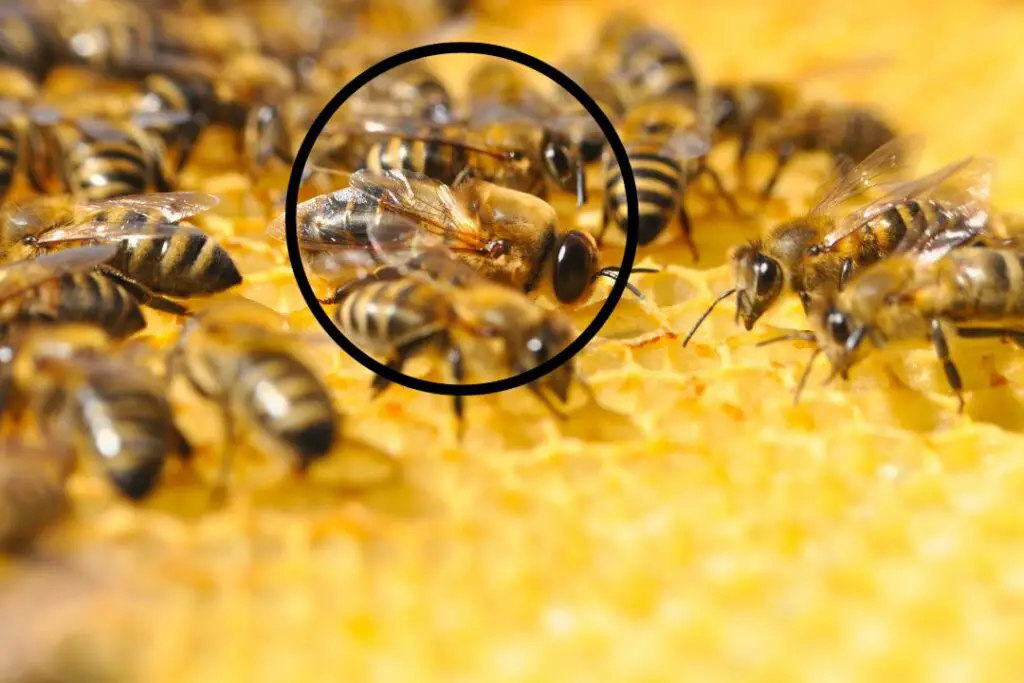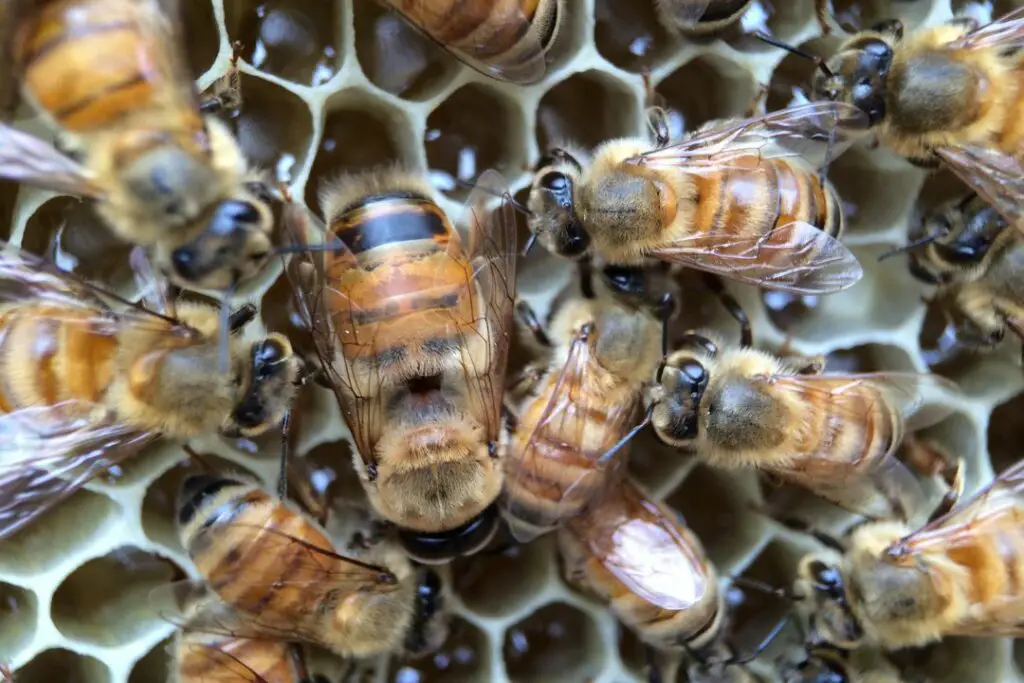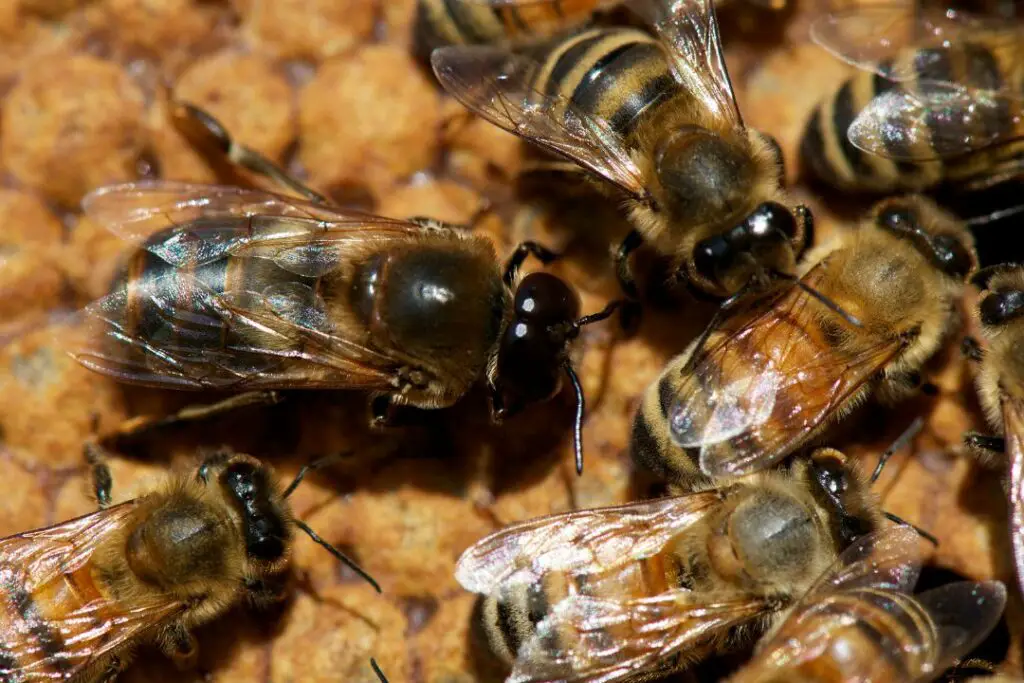Drones are the male bees of the hive. Their sole job is to mate with a queen and pass on their genetics to the next generation of bees.
But the life of a drone isn’t a long one. From the hive to a mating flight, their life is full of danger.
Let’s join the often-overlooked male bee from larvae to adulthood as it strives to fulfil its only goal.
What Do Male Honey Bees Look Like?

Drone bees are the male bees in the honey bee colony. Unlike their female counterparts, the workers and the queen, drones have a set of distinct characteristics:
- Size and Shape: Drones are larger and have a more robust body compared to worker bees. They possess a rounded abdomen, which is a noticeable feature when comparing them to the slender queen and workers.
- Eyes: They have large compound eyes that meet at the top of their head, essential for spotting the queen during mating flights.
- Wings: Drones have large wings relative to their body size, which is crucial for their primary role (mating with the queen).
- No Stinger: Unlike female bees, drones don’t have a stinger. They can’t defend the hive, and they’re harmless to predators.
- Mouthparts: Their mouthparts are designed for eating but not for collecting pollen or producing wax.
What’s Their Role In The Hive?
The drone bee’s role in the hive is singular but vital:
- Mating with the Queen: The drone’s primary goal is to mate with a virgin queen. This ensures the continuation and genetic diversity of the bee population.
- Genetic Contribution: Drones carry only their queen’s genes, which means they are vital for spreading the queen’s genetics to the next generation of bees.
- Temperature Regulation: Drone contribute to maintaining the hive’s temperature, aiding in brood incubation during their brief life inside the hive.
Drones live solely for mating and do not participate in other bee tasks like foraging for nectar or pollen, caring for the young, or maintaining the hive.
The Birth and Life of a Drone Bee
The life of a drone bee begins in the hive’s brood cells.
- Egg Stage: The queen lays an egg in a slightly larger drone cell in the wax comb. But, unlike worker bees, the egg isn’t fertilized.
- Larval Stage: In three days, the unfertilized egg hatches into a larva. Nurse bees feed the larva royal jelly at first, then switch to a diet of honey and pollen.
- Pupal Stage: After six days, the larva spins a cocoon around itself, becoming a pupa. It’s during this stage that the drone’s distinctive features develop, such as its large eyes, body shape, and wings.
- Emergence: Approximately 14 days after the egg was laid, the adult drone emerges from the cell fully grown but will spend the next few days maturing before he can fly out to mate.
Even in adulthood, drones depend on worker bees for food until they take flight.

The Mating Flight
Mating or nuptial flights usually happen during the warmest part of the day, when virgin queens are most likely to be in the air.
Sexually mature drones fly to specific areas, known as drone congregation areas.
These areas can have hundreds or even thousands of drones from various hives waiting to mate.
Once a virgin queen enters a DCA, drones are attracted to her presence through pheromones and begin a high-speed chase.
Honey bee mating is a competitive affair, with potentially hundreds of drones vying for the chance.
How do drones mate?
When a drone successfully mates with a receptive queen, he transfers his sperm to her spermatheca, where it will be stored and used to fertilize eggs throughout her entire life.
This process is crucial for the genetic diversity of honey bees.
Queens mate with multiple drones (up to 20), which helps ensure a broad genetic mix in the offspring, contributing to the colony’s resilience.
If a drone succeeds in mating, its role ends here. The act is a death sentence for our male bee.
Why do drones die when they mate?
Mating with queens is dangerous work. The mating lasts seconds, and it’s not till the drone tries to fly away that problems arise.
His reproductive organs become lodged inside the queen and tear away as the drone leaves.
This leads to catastrophic injuries for the bee and a quick death.
What’s The Life Expectancy Of A Drone?
As you can probably guess already, drones don’t live too long.
If they’re unsuccessful in multiple mating flights, a drone can live anywhere from 20-50 days, depending on food and the hive’s health.
But drone honey bees have to look over their shoulder at their kin as resources grow scarcer.
Winter evictions
As the colder months set in and nectar and pollen supplies start to dwindle, honey bees rely on their honey stores for sustenance.
The female worker bees quickly set their sites on the unproductive drones as an unnecessary drain on the hive’s resources.
Offending bees will led out of the colony before being forcefully ejected from the hive.
And the same can happen if there’s a food shortage.
Since drones can’t forage or defend themselves, they’ll quickly fall prey to predators or the elements.
Here’s a short clip of some unfortunate drones getting evicted when they’re no longer needed.
In Conclusion
In the tapestry of the hive, every bee has its thread to weave, and the drone is no exception. Though short and fraught with peril, their life is essential to the hive.
So, the next time you spot a honeybee bustling from flower to flower, spare a thought for the drone, whose silent toil underpins the colony’s survival.
Head over to our read on what honey bees do at night for more fascinating insights into the world of bees.




